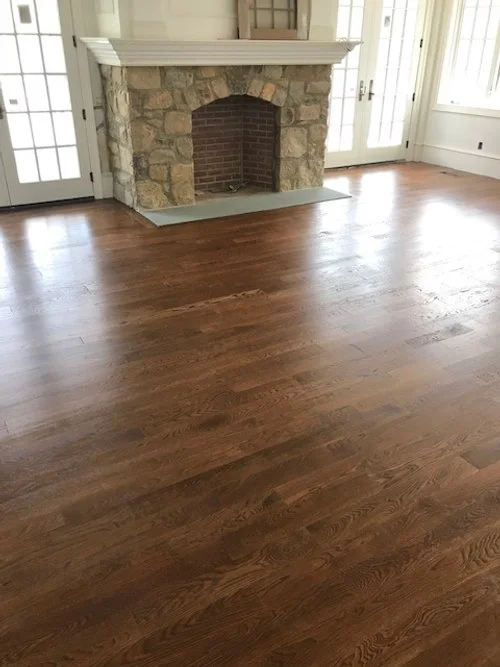Wide Planks, Perfected: Why Your Luxury Home Needs a Nailing and Gluing Installation
5” Handscraped Oak
If you are renovating a custom home in Villanova, installing a new build in Malvern, or upgrading a historic estate in Lower Merion, the wide plank hardwood look is a definitive choice for luxury.
However, the wider the board, the higher the risk of gapping, crowning, or cupping. A traditional nail-down installation, which works fine on standard 3" oak, is simply inadequate for 7"-10" planks in the climate extremes of the Philadelphia area.
This isn't a design post; this is a technical warning from a contractor who works on the Main Line every day. We explain why the glue-assist method is not a luxury—it’s a non-negotiable requirement for long-term success in your high-value home across Chester, Delaware, and Montgomery Counties.
The Wide Plank Problem: The Physics of Movement
Wood moves. It expands in the humid summer and contracts in the dry, furnace-heated winter. This is a fact of life in the Northeast.
1. The Ratio of Movement
A 10-inch wide plank has more than three times the potential for moisture-driven movement than a standard 3-inch board. When that movement happens, a nail every 8-12 inches is often not enough to restrain the board, leading to unsightly gapping and irreversible warping.
2. Subfloor Sensitivity
High-end Main Line homes often have complex subfloor conditions—concrete slabs, older plywood over masonry, or radiant heat systems. These environments are prone to higher localized moisture content (MC) fluctuations that conventional nailing cannot handle.
If your installer doesn't address these two factors, your expensive wide plank floor will fail, regardless of the species or quality of the wood.
The Only Solution: The Glue-Assist and Full Glue-Down Methods
To successfully install wide planks (typically 5 inches or wider), we combine mechanical fasteners (nails) with high-performance elastomeric adhesive (glue). This is the glue-assist method.
1. The Role of the Glue
The adhesive acts as a vapor barrier and a moisture inhibitor under the plank, providing a layer of protection from the subfloor's moisture content. Critically, it also provides shear strength and continuous restraint across the entire width of the board, stopping the cupping and crowning that nails alone cannot prevent.
2. Subfloor Prep: The Unsung Hero
For a glue-assist installation to work in a Wayne or Radnor basement or first-floor slab installation, the subfloor must be perfectly prepared. We follow a strict three-step protocol:
Flattening: The subfloor must be perfectly flat (usually within 1/8" over 10 feet). We use specialized leveling compounds to ensure the adhesive has 100% surface contact.
Moisture Content (MC) Testing: We never assume the subfloor is dry. We use a professional-grade meter to test the concrete or plywood MC, often requiring a concrete moisture mitigation system before we even open the box of wood.
Vapor Barrier: The adhesive we use (typically a high-quality urethane or moisture-cure product) must also function as a vapor barrier to protect the wood from residual moisture.
Wide Plank Use Cases on the Main Line
Our decades of experience on the Main Line dictate specific installation choices based on the unique properties of these multi-million dollar homes:
1. Custom Homes with Radiant Heat (e.g., Bryn Mawr, Villanova)
Requirement: Full Glue-Down Method. For any floor over a hydronic (water-based) radiant heat system, the full glue-down method is required. The adhesive bonds the wood directly to the subfloor, maximizing heat transfer and minimizing the movement that the constant temperature cycles induce. Nail-down only will fail.
2. Historic Stone Mansions (e.g., Malvern, Chester Springs)
Requirement: Glue-Assist on Structural Plywood. Older homes often have structural quirks and higher basement humidity. The full, continuous adhesion of the glue-assist method provides the security needed to hold these wide boards flat over older or less-than-perfect subfloors.
3. Concrete Slab Installations (High-Rise Philly & City Suburbs)
Requirement: Full Glue-Down with Vapor Barrier Adhesive. Concrete slabs are notorious for residual moisture. A full glue-down using an adhesive that specifically inhibits moisture is the only acceptable professional method to prevent the floor from failing from below.
Why Choose Cyclone for Your Main Line Wide Plank Floor
We are not generalists. We are technical experts specializing in the high-stakes installations demanded by the Philadelphia, Chester, Delaware, and Montgomery markets. We guarantee our work by following protocols that others skip:
Dedicated Tools: We invest in specialty wide-plank rollers, advanced MC meters, and premium adhesives—tools standard contractors don't carry.
Zero-Drama Schedule: We understand that high-end projects operate on tight timelines. Our precise prep work ensures we hit our installation start and finish dates, minimizing delays for other trades.
Installation Warranty: We back our wide plank glue-assist installations because we trust our process.
Don't risk your high-end investment on an installer who cuts corners with a simple nail-down technique. For the stability and longevity required on the Main Line, the glue-assist method is your insurance.

